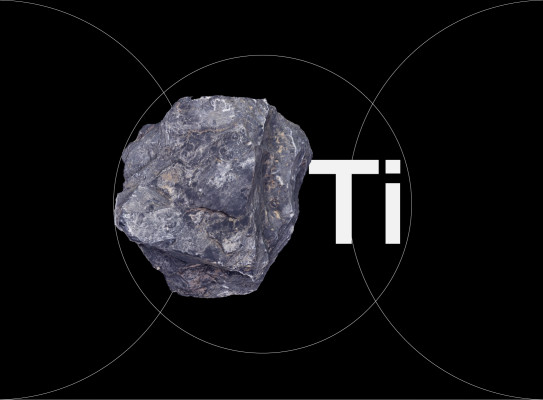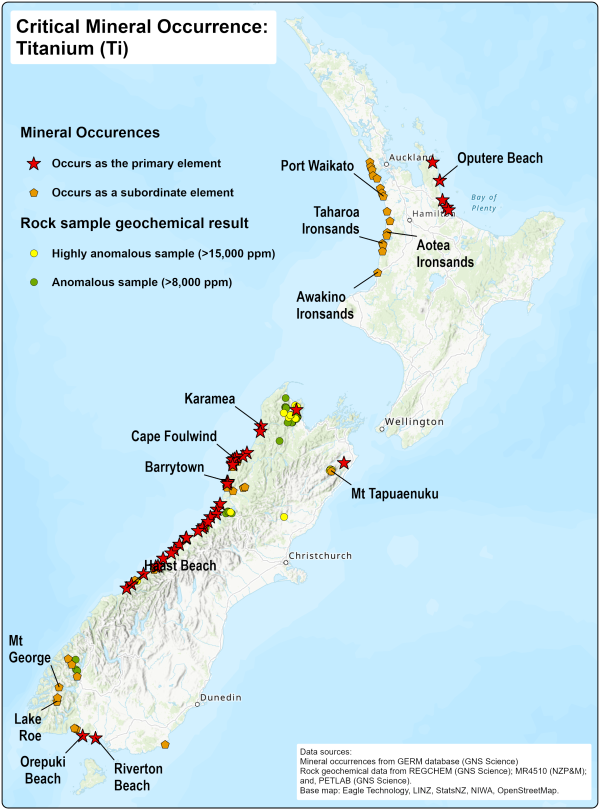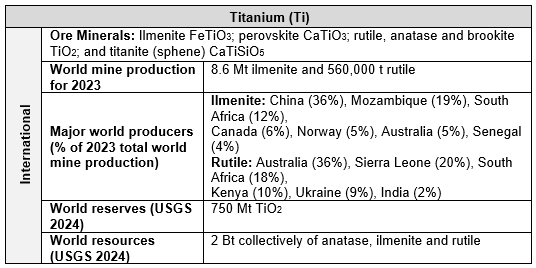Titanium

Titanium (Ti) is a critical element with essential applications in modern society due to its exceptional strength, corrosion resistance, and biocompatibility. It is widely used in aerospace, medical, industrial, and consumer applications, making it a strategically important metal.
Titanium in New Zealand
Titanium-bearing minerals, particularly ilmenite (FeTiO₃), are found in both magmatic and placer (beach sand) deposits across New Zealand. These deposits offer significant potential for titanium production, though challenges remain in processing and commercial viability.

Key Deposits and Economic Potential
-
Placer (Beach Sand) Titanium Deposits
- West Coast, Southland & Coromandel Peninsula contain Holocene beach and dune sands rich in ilmenite.
- West Coast South Island hosts an extensive 320 km-long coastline deposit from Karamea to Bruce Bay, with ilmenite concentrations of 10–25% in black sand leads and up to 6% in dune sands.
- Southland beaches (Coal River, Te Wae Wae Bay, Orepuki, Riverton, Rakiura/Stewart Island) also contain ilmenite.
- Associated heavy minerals: magnetite, garnet, zircon, rutile, and traces of gold, monazite, and rare earth minerals.
-
Major deposits
- Westport: 122 Mt of sand (4.5% ilmenite, 5.5 Mt contained ilmenite).
- Barrytown: 50 Mt of sand (13.8% ilmenite, 6.9 Mt contained ilmenite). Mining began at Westport in 2023, with Barrytown expected to start in 2024.
-
Magmatic Fe-Ti-V Deposits
- Ilmenite and magnetite occur as stratiform segregations in gabbroic and dioritic intrusions.
-
Key locations
- Mt George (Fiordland) – best-known site, part of a 90 km-long belt of gabbroic intrusions from Mt Soaker to Lake Poteriteri. Contains layers of magnetite-ilmenite with 3–25% magnetite and up to 2% sulfides. Magnetite concentrates average 1.2–1.4% V₂O₅.
- Other sites in Fiordland: Howitt Peaks, Mt Troup (Doubtful Sound), Wilmot Pass, Lake Roe, Bow Lake, and Lake Te Anau.
- Mt Pisgah (Northwest Nelson), Mt Tapuaenuku & Blue Mountain (Kaikōura Ranges) – ilmenite occurs in diorite and gabbroic rocks.
- Gabbro intrusions reach thicknesses of more than ~200 metres, hosting oxide-rich layers of magnetite and ilmenite.
-
By-Product Titanium from Ironsands
- West Coast North Island ironsands contain 7–8% TiO₂, but recovery of titanium minerals has been unsuccessful so far.
- New Zealand Steel has explored producing a 40–45% TiO₂ concentrate from ilmenite, leucoxene, and rutile at Waikato North Head, for potential use in ferrotitania steel alloys.
Economic and Mining Potential
- West Coast placer sands are a major titanium resource but have a lower-grade TiO₂ content (45–47%) compared to global standards.
- Ongoing and planned mining at Westport and Barrytown could boost ilmenite, zircon, and gold production.
- Magmatic Fe-Ti-V deposits hold potential for vanadium and titanium recovery, but require further investigation for economic viability.
These deposits represent a valuable but underdeveloped resource for New Zealand, with ongoing exploration and potential new processing methods shaping future production.
Why Titanium is important
-
High Strength-to-Weight Ratio
- Titanium is as strong as steel but 45% lighter, making it ideal for aerospace and automotive applications, reducing fuel consumption and emissions.
- Used in aircraft frames, jet engines, and spacecraft components.
-
Exceptional Corrosion Resistance
- Titanium naturally forms a protective oxide layer, making it highly resistant to rust, seawater, and chemical corrosion.
- Essential for marine structures, desalination plants, and chemical processing industries.
-
Biocompatibility for Medical Uses
- Titanium is non-toxic and does not react with the human body, making it the preferred material for medical implants, such as:
- Artificial joints (hip, knee, dental implants)
- Bone plates and surgical instruments
- Used in prosthetics and pacemakers due to its durability and compatibility with body tissues.
-
Essential for High-Performance Alloys
- Alloyed with aluminium, vanadium, and iron to create strong, heat-resistant materials.
- Used in military applications, power plants, and sports equipment.
-
Vital for Pigments and Coatings
- Titanium dioxide (TiO₂) is a non-toxic, bright white pigment used in:
- Paints, coatings, and plastics
- Sunscreens and cosmetics (provides UV protection)
- Food and pharmaceuticals as a colouring agent
-
Emerging Role in Green Technologies
- Used in hydrogen production, energy storage, and next-generation batteries.
- Plays a role in photocatalysis, enabling self-cleaning surfaces and pollution reduction.
Geological Context of Titanium Deposits
Titanium is primarily sourced from the minerals ilmenite (FeTiO₃), rutile (TiO₂), leucoxene, and occasionally from anatase and perovskite. These minerals are found in a range of geological environments, with heavy mineral sands and magmatic deposits being the most economically significant.
Major Deposit Types
-
Heavy Mineral Sand (HMS) Deposits (Placer Deposits)
- The most important source of titanium globally, supplying most of the world’s ilmenite and rutile.
- Formed by weathering and erosion of igneous and metamorphic rocks, with subsequent sorting and concentration in coastal, fluvial, and aeolian environments.
- Often associated with other heavy minerals like zircon, monazite, and magnetite.
- Found in Australia, South Africa, India, Madagascar, Mozambique, and the USA.
Examples: Richard’s Bay (South Africa), Murray Basin (Australia), and Tapira (Brazil).
-
Magmatic Titanium Deposits
- Ilmenite and titanomagnetite are found in mafic and ultramafic intrusive complexes.
- Titanium is enriched during the crystallisation of large layered intrusions.
- Associated with ferro-titanium oxide ore bodies hosted in gabbroic, noritic, and anorthositic rocks.
Examples:
- Bushveld Complex (South Africa) – world’s largest layered intrusion with significant Fe-Ti-V deposits.
- Lac Tio (Canada) – world’s largest hard-rock ilmenite deposit.
- Tellnes (Norway) – large ilmenite-bearing anorthosite deposit.
-
Metamorphic Deposits
- High-grade metamorphism can cause rutile and ilmenite to be concentrated in gneisses and schists.
- Often found in orogenic belts and high-pressure metamorphic terranes.
Examples: Eastern Blue Ridge (USA), Kazakhstan, and Brazil.
-
Hydrothermal and Residual Deposits
- Titanium minerals can be remobilised and concentrated by hydrothermal fluids.
- Lateritic weathering of mafic-ultramafic rocks can also enrich titanium, forming residual deposits.
Examples: Titanium-enriched laterites in Cameroon and Brazil.
Exploration Considerations
- Heavy mineral sands are explored using auger drilling, ground-penetrating radar, and heavy mineral separation techniques.
- Magmatic deposits require geophysical surveys (magnetics, gravity), petrographic analysis, and diamond drilling.
- Metamorphic and hydrothermal deposits are identified through geochemical anomalies and structural mapping.

Additional Reading
Brathwaite RL, Christie AB. 2006. Review of shoreline placer ilmenite deposits in New Zealand. In: Christie AB, Brathwaite RL, editors. Geology and exploration of New Zealand mineral deposits. Parkville (AU): Australasian Institute of Mining and Metallurgy. p. 43–48. (Australasian Institute of Mining and Metallurgy monograph series; 25).
Christie AB, Brathwaite RL. 1998. Mineral commodity report 16: titanium. New Zealand Mining. 23:15–25.